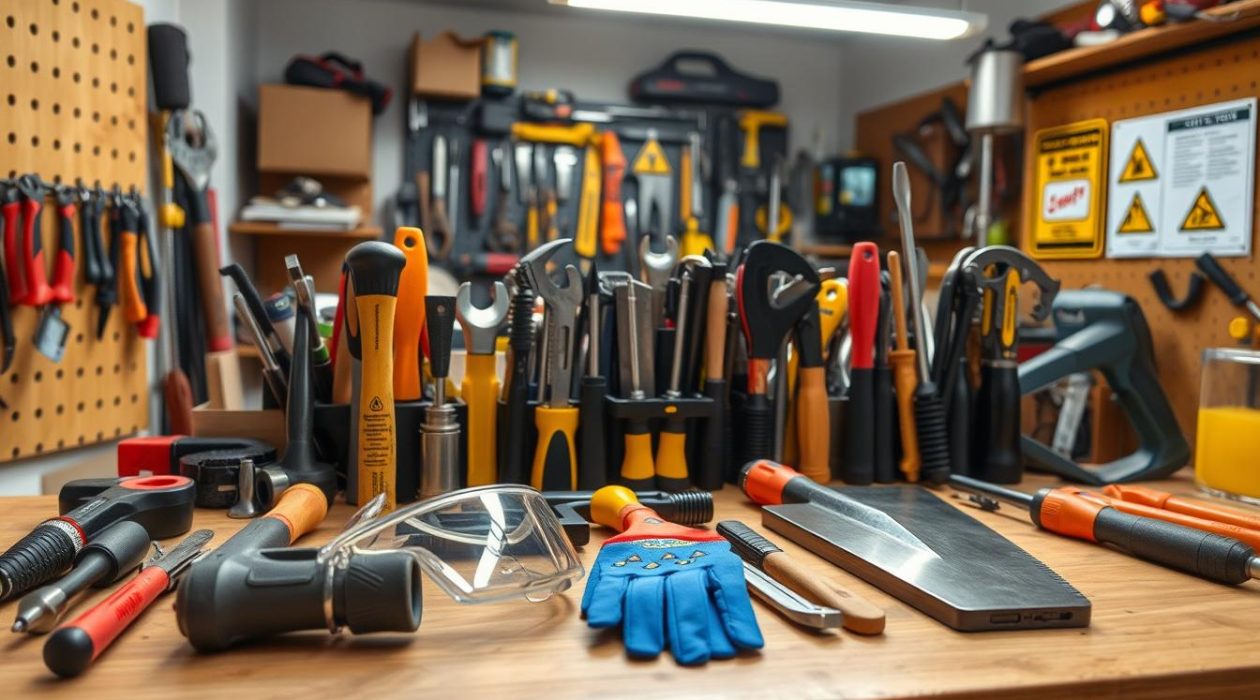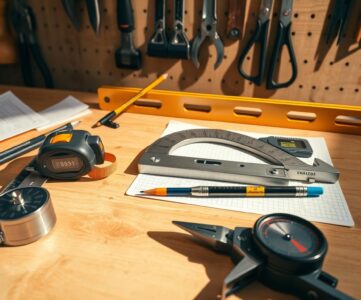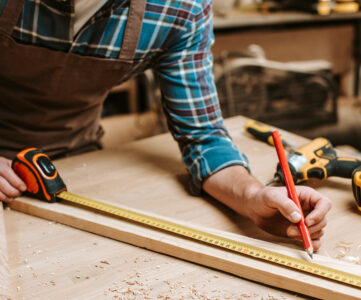DIY projects require a focus on hand tool safety to avoid accidents and achieve success. Ensuring safety should always be the primary concern. By understanding the risks of hand tool use, individuals can take steps to reduce hazards and create a secure workspace.
Protecting oneself from injuries and property damage is key when using hand tools. Recognizing the importance of safety in DIY projects leads to a safer and more enjoyable experience. Implementing proper safety measures can prevent accidents and is crucial for handling hand tools safely.
Introduction to Hand Tool Safety
DIY project safety is paramount, and hand tool safety is a critical component. Adhering to safety guidelines and being mindful of risks helps to minimize hazards and ensure a safe environment. Hand tool safety goes beyond accident prevention; it also enhances the overall DIY experience.
Key Takeaways
- Hand tool safety is crucial for preventing accidents and ensuring a successful DIY project outcome
- DIY project safety should always be the top priority
- Following proper hand tool safety guidelines can minimize hazards and create a safe working environment
- Understanding the potential risks associated with hand tool usage is essential for DIY project safety
- Proper hand tool safety techniques can help prevent accidents and ensure a safe and enjoyable DIY experience
- Hand tool safety is essential for protecting oneself from injuries and damage to property
Essential Tool Safety Principles for DIY Success
In DIY projects, safe tool usage is key to avoiding hand tool accidents prevention. Knowing the basics of tool safety can be the difference between a successful project and a visit to the emergency room. To ensure a safe and enjoyable DIY experience, it’s vital to understand the fundamental principles of tool safety.
Understanding tool safety ratings is a crucial aspect of tool safety. These ratings offer valuable insights into the tool’s intended use, safety features, and potential hazards. By familiarizing yourself with these ratings, you can make informed decisions about which tools to use for your project and how to use them safely.
Understanding Tool Safety Ratings
Tool safety ratings are indicated by a label or symbol on the tool or its packaging. These labels provide critical information about the tool’s safety features, such as protective gear requirements or potential hazards. By taking the time to read and understand these labels, you can significantly reduce the risk of accidents and ensure a safe working environment.
Basic Safety Guidelines for All Hand Tools
There are basic safety guidelines that apply to all hand tools, regardless of the specific tool or project. These include wearing protective gear, such as gloves and safety glasses, and ensuring the tool is properly maintained and stored. By following these guidelines, you can prevent hand tool accidents prevention and ensure a safe and successful DIY experience.
Importance of Tool Maintenance
Regular tool maintenance is essential to prevent accidents and ensure optimal tool performance. This includes cleaning and inspecting tools regularly, storing them properly, and replacing worn or damaged parts. By prioritizing tool maintenance, you can extend the life of your tools and prevent accidents caused by faulty or damaged equipment.
Choosing the Right Personal Protective Equipment
When it comes to hand tool safety and DIY project safety, selecting the right personal protective equipment (PPE) is key. PPE acts as a barrier, preventing injuries and ensuring a safe workspace. Essential items for DIY projects include gloves, safety glasses, and ear protection.
Gloves shield your hands from cuts, abrasions, and chemical burns. Safety glasses protect your eyes from debris, dust, and other particles. Ear protection guards against hearing damage from loud noises. Wearing the correct PPE minimizes injury risk and ensures a successful DIY project.
- Assess the risks involved in the project
- Choose PPE that is suitable for the task
- Ensure a proper fit to prevent accidents
By adhering to these guidelines and prioritizing hand tool safety and DIY project safety, you can establish a safe and healthy workspace. This benefits both yourself and others involved.
Remember, investing in PPE is crucial for any DIY enthusiast. It prevents injuries, reduces risks, and ensures a successful project outcome. So, take the time to select the right PPE for your next DIY project. Enjoy a safe and rewarding experience.
Understanding Your Hand Tools Before Starting
To ensure safe tool usage, it’s essential to grasp your hand tools before embarking on a DIY project. This entails reading the tool manuals and instructions, identifying the tool’s limitations, and considering compatibility and usage scenarios. By taking these steps, you can avoid hand tool accidents and guarantee a successful outcome.
Here are some key points to consider for hand tool accidents prevention:
- Read and follow the manufacturer’s instructions for each tool
- Understand the tool’s limitations and capabilities
- Choose the right tool for the job to avoid accidents
Also, considering tool compatibility and usage scenarios is crucial to prevent accidents. For instance, using a tool in a manner not intended can lead to hand tool accidents. By dedicating time to comprehend your tools and their proper use, you can ensure a safe and successful DIY endeavor.
By focusing on safe tool usage and hand tool accidents prevention, you can create a safe and enjoyable DIY experience. Always read and adhere to the manufacturer’s instructions, understand the tool’s limitations, and select the appropriate tool for the task.
| Tool | Safe Usage Tips |
|---|---|
| Hammer | Hold the hammer correctly, avoid over-swinging |
| Saw | Use the correct saw for the job, keep fingers away from the blade |
| Drill | Hold the drill firmly, keep loose clothing tied back |
Creating a Safe Workspace for DIY Projects
Ensuring DIY project safety starts with a safe workspace. A well-organized and well-lit area is key to preventing accidents and ensuring project success. Key factors include lighting, ventilation, and storage. Adequate lighting helps you see clearly, reducing errors and accidents. Good ventilation removes dust and fumes, keeping the air clean.
Hand tool safety is also vital. Keep tools in good condition and store them properly when not in use. This prevents accidents and maintains tool functionality. Here are some tips for a safe workspace:
- Keep the workspace clean and clutter-free
- Use a workbench or table to keep tools and materials organized
- Store tools and materials in a dry, secure location
By following these tips, you can create a safe and efficient workspace for your DIY projects. Remember, DIY project safety is everyone’s responsibility. Taking the time to create a safe workspace ensures a successful and enjoyable project.
A safe workspace is not just about preventing accidents, it’s also about creating an environment that allows you to work efficiently and effectively. By taking the time to set up a safe and well-organized workspace, you can help ensure a successful and enjoyable DIY project.
Proper Storage and Maintenance of Hand Tools
Proper storage and maintenance of hand tools are crucial for preventing accidents and ensuring safe tool usage. Regular cleaning and inspection help identify potential issues early. By making these habits part of your routine, you can greatly reduce accident risks and keep your tools in top condition.
Storage needs vary by tool type. Metal tools need a dry place to avoid rust. Tools with moving parts should be stored securely to prevent damage. Effective storage solutions include:
- Toolboxes with separate compartments for organization
- Wall-mounted tool holders for easy access
- Storage bins for small parts and accessories
Regular maintenance is also key to tool longevity. Clean and inspect tools after each use. Apply rust prevention measures like oil or wax. These simple steps help keep your tools in good shape and lower accident risks.
By focusing on proper storage and maintenance, you ensure safe tool usage and prevent accidents. Always follow the manufacturer’s instructions for specific tools. Take necessary precautions when using power tools or sharp objects.
| Tool Type | Storage Solution | Maintenance Requirement |
|---|---|---|
| Metal Tools | Dry storage | Regular cleaning and oil application |
| Tools with Moving Parts | Secure storage | Regular inspection and lubrication |
Common Hand Tool Accidents and Prevention Strategies
When tackling DIY projects, hand tool safety is paramount to avoid accidents. Studies show that most injuries from DIY tasks stem from improper tool usage. It’s vital to recognize common dangers and implement preventive actions.
Accidents like cuts, bruises, and eye injuries are common. These can be averted by wearing protective gear, such as gloves and safety glasses. Also, ensure your workspace is well-lit and free from clutter. DIY project safety demands correct tool usage and adherence to the manufacturer’s guidelines.
- Use tools with ergonomic handles to reduce fatigue and improve grip
- Keep loose clothing and long hair tied back to avoid entanglement with tools
- Avoid using tools near water or in humid environments to prevent electrical shock
Adopting these preventive measures and being vigilant about hand tool safety and DIY project safety can greatly lower accident risks. Always handle tools with care and focus, and never use them when tired or distracted.
Emergency Response for Tool-Related Injuries
Preparation is key in preventing hand tool accidents. Every second matters in the event of a tool-related injury. It’s vital to have a plan for safe tool usage and minimizing harm. A well-stocked first aid kit and basic first aid knowledge can greatly impact an emergency’s outcome.
During a hand tool accident, staying calm and assessing the situation is crucial. If the injury is severe, call for medical help right away. For less severe injuries, basic first aid can be applied. This includes cleaning and dressing the wound, applying pressure to stop bleeding, and immobilizing the affected area if necessary.
Basic First Aid for Tool Accidents
- Stop bleeding by applying pressure
- Clean and dress the wound
- Immobilize the affected area if necessary
Knowing when to seek medical attention is also important. If the injury is severe or shows signs of infection, such as redness, swelling, or increased pain, seek medical help immediately. By focusing on hand tool accidents prevention and safe tool usage, you can reduce injury risk and ensure a safe work environment.
Creating an Emergency Response Plan
A well-thought-out emergency response plan is essential for quick and effective action in tool-related injuries. This plan should include emergency services contact information, a list of basic first aid supplies, and a step-by-step guide for common injuries.
| Emergency Contact | Phone Number |
|---|---|
| Emergency Services | 911 |
| Poison Control | 1-800-222-1222 |
Teaching Tool Safety to Others
Sharing your DIY project safety knowledge with family members is crucial. By teaching others about tool safety, you can prevent accidents and foster a safety-aware environment at home. Hand tool safety is a vital part of DIY projects. Educating others on its significance can greatly impact safety.
Training Family Members
To educate family members, begin by covering the basics of DIY project and hand tool safety. Use a bulleted list to highlight key points, such as:
- Reading tool manuals and instructions
- Understanding tool limitations and compatibility
- Wearing personal protective equipment
Creating Safety Checklists
Creating safety checklists is another effective method to promote DIY project and hand tool safety. Develop a checklist that includes items such as:
- Inspecting tools before use
- Storing tools properly
- Following safety guidelines for specific tools
By teaching tool safety and promoting a safety-conscious culture, you can prevent accidents. This ensures a safe and enjoyable DIY experience for all.
| DIY Project Safety Tips | Hand Tool Safety Tips |
|---|---|
| Read tool manuals and instructions | Inspect tools before use |
| Wear personal protective equipment | Store tools properly |
Advanced Tool Safety Techniques for Complex Projects
When tackling complex DIY projects, hand tool accidents prevention is paramount for a safe and successful outcome. Utilizing specialized tools and equipment tailored for specific tasks is key. For instance, a rotary hammer excels in heavy-duty drilling and demolition, whereas a precision screwdriver is perfect for intricate electronics work.
Understanding the unique challenges and risks of complex projects is vital for safe tool usage. This includes being mindful of hazards like electrical shock, falling objects, and entanglement with power tools. By carefully assessing the project’s needs and planning, DIY enthusiasts can lower accident risks and maintain a safe workspace.
Advanced tool safety techniques for complex projects include:
- Using protective gear such as gloves, safety glasses, and a dust mask
- Implementing a buddy system to ensure someone is always present to provide assistance
- Regularly inspecting tools and equipment to ensure they are in good working condition
By adopting these techniques, DIY enthusiasts can significantly reduce hand tool accidents and enhance their working environment’s safety and efficiency. Remember, safe tool usage is crucial for achieving professional-grade results and safeguarding oneself from harm.
Making Tool Safety Your Priority
As you start your next DIY project, remember that hand tool safety is key to success. Prioritizing safety at every step protects you, your loved ones, and your project investment. From choosing the right protective gear to keeping tools in good condition, each safety measure is crucial.
This article has highlighted the critical role of DIY project safety and the importance of handling tools responsibly. By adopting these safety practices, you cultivate a mindset focused on safety for all your DIY projects. Safety is more than a checklist item; it’s a mindset that should guide your work.
With the right knowledge and a dedication to safety, you can approach your DIY projects with confidence. You’ll know you’re protecting yourself and others. By prioritizing tool safety, you’ll enjoy the fruits of your labor without risking your health. This marks the beginning of a safer, more fulfilling DIY journey.






